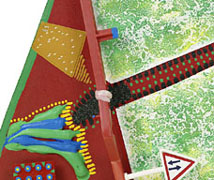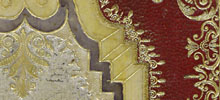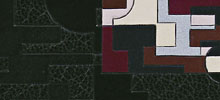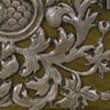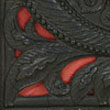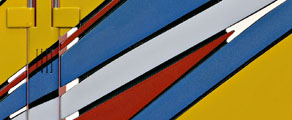Bookbindings of the Koninklijke Bibliotheek (KB), The National library of the Netherlands > Unique materials
In decorating the bookbinding, the binder appears to be restricted by the rectangular format. Besides, the binding should, as a product of applied art, not make handling and reading too difficult.
A work of art?
Daniël Knoderer's binding is a borderline case. This imaginative bookbinding artist made a binding of calf leather and painted paper. On this he fixed plastic children's toys and then decorated it entirely with felt-tip pens. He was also responsible for the contents. A book to be looked at. Is it a work of art?
Knoderer's bookbinding apparently appears to be far removed from traditional book bindings, but does fit into a historical development. In the past, bookbinders mainly made use of different types of leather and loose decorative stamps to adorn the bindings. There were bindings made of calf leather, pig leather and sheep leather. Parchment was also often used. Goat leather proved easy to color and became very popular for luxury bindings. The leather was, for example, marbled, partly dyed or processed into ingenious figures using techniques that are still used today.
Textile
But besides leather all sorts of unique materials were used. As far back as the Middle Ages textiles were already used to bind books. This material, often beautifully embroidered, can, for instance, be seen on bindings dating back to the 17th century but also on bindings from the early 20th century.
Metal
Metal, originally only used for fittings and locks, was also used for complete binding covers. Modern binders also work with this material.
Sharks and turtles
Particularly striking are the bindings using turtle and so-called sharkskin. The latter, however, usually turns out to be different leather that has been embossed with a special grain.
Experimenting with new materials
In the 19th century there were many examples of materials that suggest something else. There was a lot of experimentation, combination and extensive use of new techniques. For example, a substance of primarily plaster was poured into a mold in order to imitate carved wood. For religious works the new synthetic celluloid was often used as it strongly resembles the much more expensive ivory. Even Bakelite, discovered in 1907, was used for making book bindings.
Modern binders ingeniously convert polycarbonate into a useable material and while respecting the tradition of the craft, make contemporary applied art.
The KB collection shows that hand-bound books are certainly an art form to be reckoned with in modern arts.

